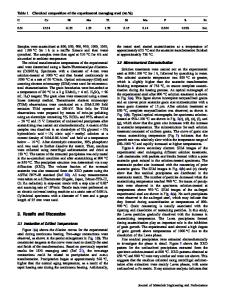Influence of banded structure on the mechanical properties of a high-strength maraging steel
- PDF / 3,423,970 Bytes
- 7 Pages / 612 x 792 pts (letter) Page_size
- 68 Downloads / 462 Views
9
International
Influence of Banded Structure on the Mechanical Properties of a High-Strength Maraging Steel M. Ahmed, L Salarn, F.H. Hashmi, and A.Q. Khan Chemical inhomogeneity results in the formation of banded structure in high-strength maraging steels. Segregation of titanium and molybdenum was found to be the primary cause of banded structure formation. When the concentrations of these elements increased beyond certain critical levels, bands comprising different grain sizes formed. The inclusions existed preferentially along the interface of the bands. A high-temperature homogenization treatment substantially reduced or eliminated the banded structure. The large grain size resulting from the homogenization treatment was subsequently reduced by a grain refinement treatment. The mechanical properties of the steel substantially improved following homogenization and grain refinement.
Keywords banded structure, grain refinement, heat treatment, homogenization, mechanical properties
[
per ASTM specifications; because of the size of the stock material, measurements were limited to the extrusion direction. Scanning electron microscopy (SEM) was used to study the fracture surfaces.
1. Introduction 3. Results and Discussion THE BANDED structure occurs quite commonly in highstrength maraging steels. Its presence has been attributed to the segregation of alloying elements during the solidification process. In subsequent forming operations such as extrusion or cold rolling, regions exhibiting segregation extend along the material flow direction. The different response to etching solutions results in the appearance of bands. Several workers have investigated the banded structure present in maraging steels. Goldberg (Ref 1) has suggested that carbon in combination with phosphorus can lead to the formation of banded structure, and Salmon Cox et al. (Ref 2) have shown that segregation of titanium, molybdenum, and nickel can also produce banding. This article examines the role of chemical inhomogeneity in forming the banded structure in maraging steel grade 18Ni(350) (2400 MPa), the effectiveness of heat treatment in reducing or eliminating the banded structure, and its influence on mechanical properties.
2. Experimental Method The stock material was received in the form of 40 mm diam extruded rods with the chemical composition given in Table 1. The banded structure could be revealed by preparing samples using conventional metallography techniques and etching with 3% nital solution. To enhance the grain size distribution, the samples were electrolytically etched using 10% chromic acid solution. Homogenization and grain refinement were carded out in an air furnace; the heat treatment cycle is shown in Fig. 1. Homogenization temperature and time varied from 1200 to 1300 ~ and 2 to 8 h, respectively. Charpy impact and tensile strengths were measured using standard samples prepared as M. Ahmed, I. Salam, F.H. Hashmi, and A.Q. Khan, Metallurgy Division, Dr. A.Q. Khan Research Laboratories, G.P.O. Box 502, Rawalpindi, Pakista
Data Loading...











